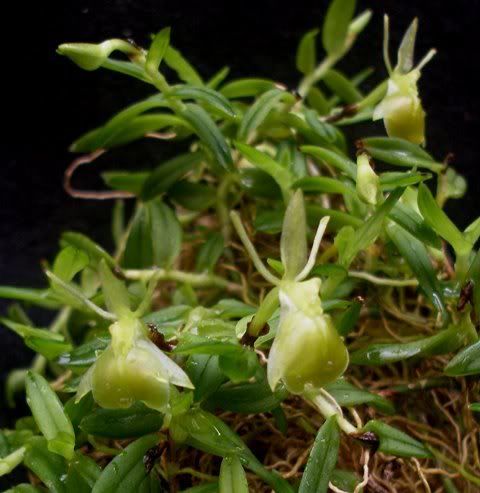


Donate Now
and become
Forum Supporter.

Many perks!
<...more...>


|

12-30-2009, 10:05 PM
|
|
Senior Member
|
|
Join Date: Dec 2009
Zone: 9b
Location: Sacramento
Posts: 387
|
|
 A division reverting in another form?
A division reverting in another form?
Today I was making a bunch of Epi. porpax divisions out of a bunch of overgrown 2" pots. These plants had been in pots for about two years maybe. Before that they were part of a large sphere, back when the genus was Neoporpax.
Upon putting these into 4" baskets, I noticed one was an alba. Weird! The leaves even displayed that alba characteristic being devoid of anthocyanins. I know that Epi porpax var. alba exists, but these were divisions off the same plant. Is it possible that it reverted to that form in the course of 2 years? Between fungicides, fertilizers, pesticides could there be something that could cause that to happen? The other option would be that a seed pod developed, and the seed developed into a blooming sized plant. Option number three, genetics changed with a new growth?
|

12-30-2009, 10:46 PM
|
 |
Senior Member
|
|
Join Date: Apr 2008
Zone: 9a
Location: Los Angeles, CA
Posts: 9,321
|
|
Are you using the loss of anthocyanins in the leaf as a determinant for whether your Epi. porpax is an alba form?
Or...
Are you determining that the division you made is an alba form via the lack of pigmentation in the flowers.
The leaves can revert from having a reddish-purple pigment back to a green coloration from cholorophyll pigments due to different levels of exposure to light.
The division that you're referring to as an "alba" may still be a normal form with all of its pigmentation.
|

12-30-2009, 11:55 PM
|
|
Senior Member
|
|
Join Date: Dec 2009
Zone: 9b
Location: Sacramento
Posts: 387
|
|
Both, I know that it would be more apparent if the plant was in a low light level and the leaves would display the purple pigmentation.
However, the flower is definitely the same as the one you would see if you googled the alba porpax.
|

12-31-2009, 12:19 AM
|
 |
Senior Member
|
|
Join Date: Apr 2008
Zone: 9a
Location: Los Angeles, CA
Posts: 9,321
|
|
This is indeed very peculiar behavior.
Since I'm not a geneticist, I can't answer this question properly.
There is a geneticist here on the OB. I forgot her screen name, I'll get back to you on this.
|

12-31-2009, 12:20 AM
|
 |
Senior Member
|
|
Join Date: Apr 2008
Zone: 9a
Location: Los Angeles, CA
Posts: 9,321
|
|
Her screen name is orchidbingo.
|

12-31-2009, 02:09 AM
|
 |
Senior Member
|
|
Join Date: Sep 2007
Zone: 8b
Location: San Antonio, Texas
Age: 45
Posts: 10,329
|
|
Sounds like you have more than one plant in the bunch.
|

12-31-2009, 04:08 AM
|
|
Senior Member
|
|
Join Date: May 2009
Posts: 688
|
|
In the first post by sos, it sounded as though the change was a vegetative variegation. I will post my previous comments on a new thread on variegations. I agree with missmolly that variegated foliage and alba flowers are not connected events.
Last edited by catwalker808; 01-01-2010 at 04:47 PM..
|

12-31-2009, 05:49 AM
|
|
Senior Member
|
|
Join Date: Feb 2007
Zone: 6a
Posts: 464
|
|
Vaiegated foliage and alba flowers are not connected events. Hostas represent the most common variegated foliage transitions. These result from chloroplast DNA, not cell nuclear DNA. As you probably know the chloroplast DNA changes are very unpredictable and revert to form or continue changing over time before stabilizing. These transitions result in a predictable array of named unstable Hosta cultivars most of which eventually become one.
The flowers are not involved in these changes.
|

12-31-2009, 07:57 PM
|
|
Senior Member
|
|
Join Date: Dec 2009
Zone: 9b
Location: Sacramento
Posts: 387
|
|
Im curious as to what will happen the next time it blooms. It seems pretty certain that the plant will produce another alba flower the next flowering, but who knows?
In my immediate thoughts yesterday, it occurred to me that this part of the plant being buried might produce more chloroplasts trying harder to photosynthesize, and possibly translated into the flower parts? The flowers arent actually devoid of pigment (picture credit to Ron-NY thanks Ron!)

Based on some similar ideas about variegation, I do think that plastids have a part to play in this. |

12-31-2009, 08:19 PM
|
|
Senior Member
|
|
Join Date: Sep 2009
Posts: 248
|
|
I've never seen this before, i have a small plant of this species myself.
May i ask what kind of media you are growing it in? Mine are currently in Epiweb but they grow slow for me
|
|
Currently Active Users Viewing This Thread: 2 (0 members and 2 guests)
|
|
|
 Posting Rules
Posting Rules
|
You may not post new threads
You may not post replies
You may not post attachments
You may not edit your posts
HTML code is Off
|
|
|
All times are GMT -4. The time now is 10:26 PM.
|































 Linear Mode
Linear Mode


